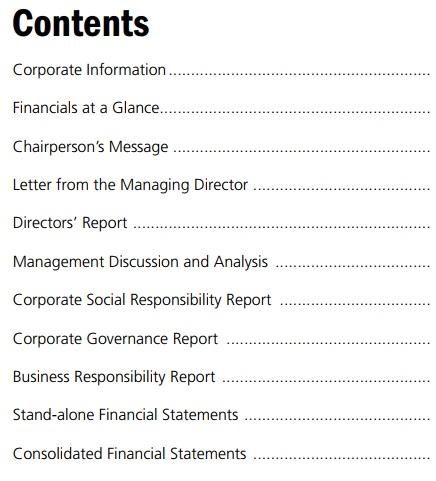
Unlike the quarterly financial statements, The Annual Report of a Company is a qualitative, quantitative, as well as a comprehensive representation of all aspects related to the historical, current and future business (prospects) of the company. While adhering to the statutory guidelines laid out by the regulatory authorities, the annual report serves as an excellent marketing and advertising document, which portrays the accountability of the management, ethos of the company and a progression of the promoter & company’s vision.
In addition to the above, information about subsidiaries & joint ventures, the progress of capital expansion plans, management & employees, investor protection & social responsibility actions is also provided in detail.
All the shareholders of the company must be provided with an annual report (hard copy or e-copy), as it serves as a means of periodic communication between the various stakeholders of the company. This helps in sharing the achievements of the company, business and otherwise, providing reassurance to the investments made by various shareholders.
The contents of a standard annual report for a company are as follows
Let us look at each of the contents & understand the importance and value of each in brief.
Corporate Information
The ‘Corporate Information’ section provides details related to the company, pertaining to the Board of Directors, Key Management Personnel, Registered Office / Corporate Office addresses, Bankers, Auditors, Registrar and Share Transfer Agent, Subsidiaries (domestic & international), Joint Ventures. Investors can infer the qualitative experience of the company’s personnel, the reputation of the auditors and the lead bankers supporting the financial needs of the company.
Financials at a Glance
Many companies provide the ‘Financials at a Glance’ section to display the financial performance of the company over a longer time period. Normally, noteworthy information pertaining to Profit & Loss statement and Balance Sheet are provided, which can help the investors to identify trends in revenue, EBITDA, Net income from the income statement and a glimpse at assets, liabilities and share capital from the balance sheet, over the last 10 years.
Chairman’s Message
In many companies, the Chairman’s position is held by one of the promoters, either in an executive or a non-executive role. The letter from the Chairman/Chairperson (a woman Chairman is referred to as Chairperson) which introduces the annual report to the shareholders, highlights the progression of the original vision for the establishment of the company. This sets the tone for understanding the business performance which is detailed in the following sections of the annual report. A qualitative message, indicating the strategic direction, advancement of the business objectives and the new initiatives/opportunities/challenges are the main takeaways of this narrative.
Letter from the Managing Director
Introducing the financial and operational performance of the company is the letter from the Managing Director or the Chief Executive Officer. This narrative is critical as the letter outlines major achievements like order book status, revenues & profits, market share growth, new product launches, major customer orders and significant achievements in the financial year. It also describes challenging factors in the business environment that have affected the company results and detail the impact on future prospects. The current performance with an outlook for the next year are the takeaways of this narrative.
Director’s Report
The Director’s Report section provides a summary on audited financials, dividends, new policies adopted, board meetings, introduction to other sections of Corporate Governance, Director’s Responsibility report, along with the appointment of statutory & cost auditors, and other key developments in the company. Financial & accounting standards, remuneration & employee welfare policies adopted and Corporate Social Responsibility (CSR) initiatives are the key takeaways of this narrative.
Management Discussion and Analysis
The most important section of the annual report for any investor, termed as the MDA, discusses the businesses and the operations of the company in extreme detail. Information pertaining to each of the operating business segments, competition, market environment, revenues, price realizations, profit margins achieved is explained by the management. While detailing the outlook prevailing during the recent financial year, the management highlights the future prospects, new initiatives, capacity additions, capex related information and other ongoing projects which can materially impact the revenues and the profitability of the company. Actual operations during the recently concluded year and the near term outlook are the key takeaways from this narrative.
Corporate Social Responsibility Report
The CSR report highlights the various initiatives undertaken by each company to support communities through the allocation of funds as well as time & efforts for their betterment. Many companies contribute close to 2% of the profits for causes relating to education, sanitation, water, skill development etc. In addition to allocating funds, companies provide other resources and also encourage employees to participate in support of these causes. Company’s contribution to the community, supporting non-profit causes are the key takeaways of this narrative.
Corporate Governance Report
While executing the business plans, it is essential for any company to follow ethical business conduct, with integrity and commitment to values, exhibiting transparency and accountability as an integral part of its efforts to retain and enhance the trust of stakeholders. This is considered the hallmark of effective corporate governance. Every company adopts a code of conduct which deals with governance practices, expected to be followed by Board members, senior management and all the employees of the company. These guidelines are highlighted in the Corporate Governance Report published as part of the annual report.
Good governance practices are an important parameter to be evaluated before investing. Some of the good governance practices are transparency, timely disclosures, supervision and internal controls, risk management, internal and external communications, standards of safety, accounting fidelity, business review processes, product/service quality.
Business Responsibility Report
Emphasizing the accountability of the listed companies to the local communities and society at large, in July 2011, the Ministry of Corporate Affairs introduced the 'National Voluntary Guidelines on Social, Environmental and Economic Responsibilities of Business' (Source). These guidelines contain comprehensive principles to be adopted by companies as part of their business practices and a structured business-responsibility reporting format, requiring certain specified disclosures, demonstrating the steps taken by companies to implement the said principles. This is termed as the Business Responsibility Report.
Out of the 5 sections (A, B, C, D, and E) specified in the format, Section E is extremely useful, which contains Principle-wise Performance and is detailed through 9 principles:
-
Principle 1 – Ethics, Transparency, and Accountability
-
Principle 2 – Product Life Cycle Sustainability
-
Principle 3 – Employee Well-being
-
Principle 4 – Stakeholder Engagement
-
Principle 5 – Human Rights
-
Principle 6 – Environment
-
Principle 7 – Policy Advocacy
-
Principle 8 – Equitable Development
-
Principle 9 – Customer Value
Stand-Alone Financial Statements
If a company has only one entity that encompasses the complete business, then the Stand-Alone Financial Statements are provided, detailing the profit & loss statement, balance sheet statement, cash flow statement, notes to accounts and the various schedules. As described in the earlier part of the section, every investor needs to read and review the financial statements for an understanding of the financial health of the company. Based on these financial statements, investment can be contemplated in that particular company.
Consolidated Financial Statements
When a company has many businesses segregated under various subsidiaries, joint ventures, and associate companies, then the Parent (holding) company provides the Consolidated Financial Statements, in addition to the stand-alone financial statements. The same format of the financial statements is followed but all financial parameters are aggregate of all the entities and their businesses.
The aim of the annual report is to communicate to the current & prospective investors, an image of a company with a good strategic direction, executed by a capable management team, by capturing appropriate business prospects, to translate into a steady financial and operational performance. Based on the financial statements and other relevant documents, an investor can perform a fundamental analysis before taking a final call for investing in the company.
Next Chapter
Comments & Discussions in
FYERS Community

Samika commented on April 25th, 2019 at 12:51 PM
Could you tell me which sections of the annual report serve as an indicator of the overall performance of the company which would be pertinent to the investor?